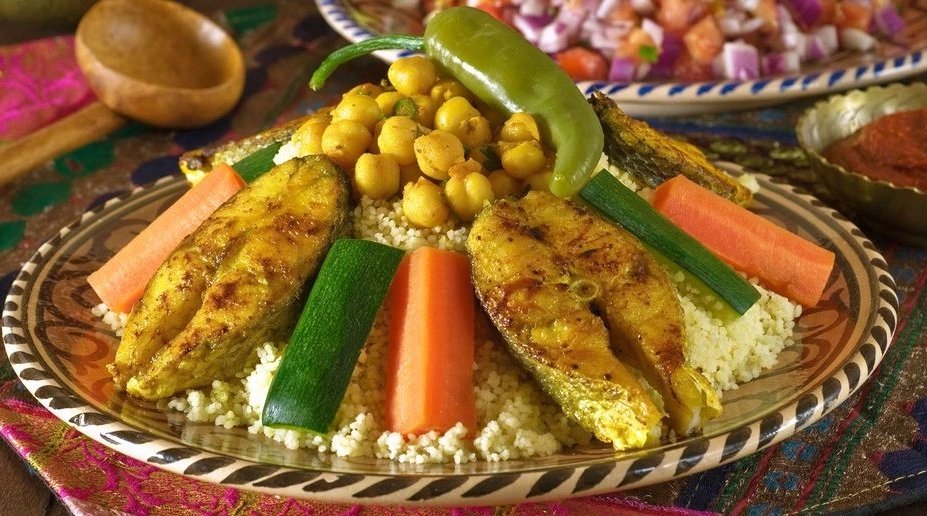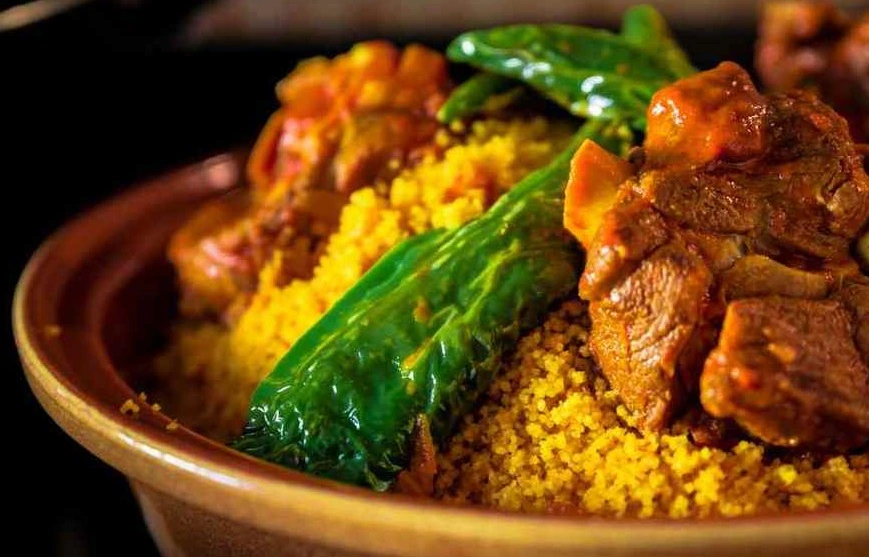Couscous is a staple food that has made its way from North African kitchens to tables around the world. This tiny pasta, often mistaken for a grain, is easy to prepare and pairs well with a variety of flavors, making it a favorite in many households.
But what exactly is couscous, and how can you make the most of it in your cooking? This guide will take you through everything you need to know about couscous, from its origins and types to cooking methods and delicious recipe ideas.
What is Couscous?
Couscous comes in different sizes, with the most common varieties being Moroccan, Israeli (also known as pearl couscous), and Lebanese.
- Moroccan Couscous: The smallest and quickest to cook, Moroccan couscous is often used in salads or as a side dish.
- Pal Couscous: Larger and chewier, this type of couscous is often toasted before cooking, giving it a nutty flavor.
- Lebanese Couscous: The largest of the three, Lebanese couscous (also known as Moghrabieh) is often slow-cooked and used in heartier dishes.
Nutritionally, couscous is low in fat and can be a good source of fiber, especially when made from whole wheat.
The History of Couscous
Couscous has a long history that dates back to North Africa, where it originated among the Berber people. It has been a staple food in the region for centuries, often served with stews or vegetables.
Types of Couscous
Couscous comes in several varieties, each with its own unique texture and cooking method:
- Moroccan Couscous: This is the most common type, consisting of very small granules that cook quickly. It’s perfect for dishes where you want a light, fluffy texture.
- Israeli Couscous: Also known as pearl couscous, this variety is larger and has a chewier texture. It’s often toasted before cooking, which adds a nutty flavor.
- Lebanese Couscous: Known as Moghrabieh, this is the largest variety of couscous. It’s typically slow-cooked and used in more substantial dishes.
Each type of couscous has its own best uses, so choosing the right one for your recipe is key to achieving the desired texture and flavor.
Why Couscous is a Favorite
Couscous is loved for its ease of preparation and versatility in the kitchen. It cooks quickly, making it an ideal choice for weeknight dinners or when you need a quick side dish. Its neutral flavor allows it to pair well with a wide range of ingredients, from bold spices to delicate herbs, making it suitable for all types of meals.
Whether served hot or cold, couscous is a dish that can be adapted to any season. It’s light enough for summer salads yet hearty enough to accompany winter stews, making it a year-round favorite.

Ingredients Needed for Cooking Couscous
The basic ingredients for cooking couscous are simple, but there are plenty of options for adding flavor:
- Couscous: Choose between Moroccan, Israeli, or Lebanese couscous depending on your recipe.
- Liquid: Water or broth is used to cook couscous,
- Olive Oil or Butter: Adds richness and helps prevent the couscous from sticking together.
- Salt: Enhances the natural flavor of the couscous.
How to Cook Couscous
Step 1: Measuring and Preparing the Ingredients
For Moroccan couscous, the standard ratio is 1:1, meaning one cup of liquid for every cup of couscous. For Israeli and Lebanese couscous, you may need slightly more liquid, as these types are larger and take longer to cook.
Step 2: Cooking the Couscous
- Moroccan Couscous: Bring the liquid (water or broth) to a boil in a pot. Remove from heat, stir in the couscous, cover, and let it sit for about 5 minutes. The couscous will absorb the liquid and become tender.
- Palestine Couscous: Toast the couscous in a bit of olive oil in a pan until golden brown, then add boiling water or broth.
- Lebanese Couscous : cooked more like pasta or risotto. Simmer it in plenty of broth or water until tender, which can take up to 20 minutes.
Step 3: Fluffing and Serving
At this point, you can add herbs, nuts, dried fruit, or other ingredients to enhance the dish. Serve it warm as a side dish, or let it cool and use it as a base for a salad.
Flavor Variations and Recipes
Couscous is incredibly versatile, and you can easily customize it to fit your taste:
- Herbed Couscous: Mix in fresh herbs like parsley, cilantro, or mint, and add a squeeze of lemon juice for brightness.
- Vegetable Couscous: Add roasted or steamed vegetables such as bell peppers, zucchini, or carrots for a more substantial dish.
- Spiced Couscous: Season with spices like cumin, coriander, or turmeric to give the couscous a warm, aromatic flavor.
- Sweet Couscous: Incorporate dried fruits like raisins or apricots, along with nuts and a pinch of cinnamon, for a sweet twist.
These variations allow you to use couscous in a variety of dishes, from light salads to hearty mains.
Serving Suggestions
- With Proteins: Serve couscous alongside grilled chicken, lamb, or fish for a complete meal.
- In Salads: Use couscous as the base for a salad, mixing in fresh vegetables, feta cheese, and a tangy vinaigrette.
- As a Side Dish: Serve couscous with stews, tagines, or curries to soak up the flavorful sauces.
Couscous’s adaptability makes it a great addition to almost any meal, whether as a main course or a side.
Common Mistakes to Avoid When Cooking Couscous
Even though couscous is easy to cook, there are a few common mistakes to avoid:
- Overcooking or Undercooking: Follow the recommended cooking times to ensure the couscous is tender but not mushy.
- Not Fluffing Properly: Failing to fluff the couscous after cooking can result in clumps.
- Using Too Much or Too Little Liquid: Stick to the correct ratio of liquid to couscous to achieve the right texture.
Avoiding these mistakes will help you make perfect couscous every time.
Tips for Perfect Couscous Every Time
To elevate your couscous dishes, consider these tips:
- Choose the Right Couscous: Match the type of couscous to the dish you’re preparing, whether it’s Moroccan, Israeli, or Lebanese.
- Use Broth for Cooking: Using broth instead of water adds more depth and flavor to the couscous.
- Add Olive Oil: A drizzle of olive oil after cooking adds richness and helps keep the couscous grains separate.
These small adjustments can make a big difference in the flavor and texture of your couscous.
Health Benefits of Couscous
Couscous is a nutritious addition to your diet:
- Nutritional Profile: Couscous is low in fat and provides a good source of fiber, particularly if you choose whole wheat couscous.
- Whole Wheat Couscous: For added health benefits, opt for whole wheat couscous, which contains more fiber and nutrients than the regular version.
- Balanced Diet: Couscous can be part of a balanced diet, especially when paired with vegetables and lean proteins.
It’s a versatile food that can fit into a variety of dietary plans, whether you’re looking for something light or more substantial.
These international variations highlight the versatility of couscous and its ability to absorb and enhance different flavors.
Storing and Reheating Couscous
Couscous stores and reheats well, making it a convenient option for meal prep:
- Storing Cooked Couscous: Place leftover couscous in an airtight container and refrigerate for up to 4 days.
- Reheating Tips: To reheat couscous, add a splash of water or broth to prevent it from drying out, and warm it gently in the microwave or on the stove.
- Freezing Couscous: Couscous can be frozen for up to 3 months. Thaw in the fridge overnight before reheating.
These storage tips will help you keep your couscous fresh and delicious, even when preparing it in advance.
Frequently Asked Questions about Couscous
What’s the difference between couscous and quinoa?
Couscous is a type of pasta made from wheat, while quinoa is a seed that’s often used as a grain substitute. Quinoa is naturally gluten-free and has a slightly nuttier flavor than couscous.
How do I keep couscous from getting sticky?
To prevent stickiness, fluff the couscous with a fork after cooking and avoid using too much liquid.
Can I use couscous in desserts?
Yes, . It’s a versatile base for both savory and sweet recipes.
Conclusion
Couscous is a versatile and easy-to-prepare food that deserves a place in your kitchen. Its ability to absorb flavors and its light, fluffy texture make it a perfect canvas for a wide range of culinary creations. So, why not explore the different types of couscous and discover your favorite way to enjoy this delicious and nutritious food?
FAQs After the Conclusion
How do I make couscous fluffier?
To make couscous fluffier, use the correct ratio of liquid to couscous and be sure to fluff it with a fork immediately after cooking.
What’s the best way to add protein to couscous?
You can add grilled chicken, shrimp, chickpeas, or tofu to couscous for a protein boost.
Can I cook couscous in a rice cooker?
Yes, . Use the same liquid-to-couscous ratio and cook on the white rice setting.
How do I prevent couscous from drying out?
If storing or reheating couscous, add a splash of water or broth to maintain its moisture.
